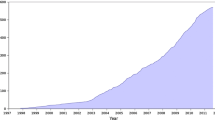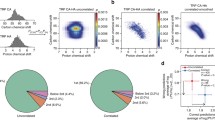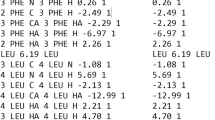Abstract
It has been demonstrated that protein folds can be determined using appropriate computational protocols with NMR chemical shifts as the sole source of experimental restraints. While such approaches are very promising they still suffer from low convergence resulting in long computation times to achieve accurate results. Here we present a suite of time- and sensitivity optimized NMR experiments for rapid measurement of up to six RDCs per residue. Including such an RDC data set, measured in less than 24 h on a single aligned protein sample, greatly improves convergence of the Rosetta-NMR protocol, allowing for overnight fold calculation of small proteins. We demonstrate the performance of our fast fold calculation approach for ubiquitin as a test case, and for two RNA-binding domains of the plant protein HYL1. Structure calculations based on simulated RDC data highlight the importance of an accurate and precise set of several complementary RDCs as additional input restraints for high-quality de novo structure determination.





Similar content being viewed by others
References
Blackledge M (2005) Recent progress in the study of biomolecular structure and dynamics in solution from residual dipolar couplings. Prog NMR Spectrosc 46:23–61
Bodenhausen G, Ernst R (1982) Direct determination of rate constants of slow dynamic processes by two-dimensional “accordion” spectroscopy in nuclear magnetic resonance. J Am Chem Soc 104:1304–1309
Brutscher B (2001) Accurate measurement of small spin–spin couplings in partially aligned molecules using a novel J-mismatch compensated spin-state-selection filter. J Magn Reson 151:332–338
Cavalli A, Salvatella X, Dobson CM, Vendruscolo M (2007) Protein structure determination from NMR chemical shifts. Proc Natl Acad Sci USA 104:9615–9620
Coggins BE, Venters RA, Zhou P (2010) Radial sampling for fast NMR: concepts and practices over three decades. Prog NMR Spectrosc 57:381–419
Cornilescu G, Marquardt JL, Ottiger M, Bax A (1998) Validation of protein structure from anisotropic carbonyl chemical shifts in a dilute liquid crystalline phase. J Am Chem Soc 120:6836–6837
Das R, André I, Shen Y, Wu Y, Lemak A, Bansal S, Arrowsmith CH, Szyperski T, Baker D (2009) Simultaneous prediction of protein folding and docking at high resolution. Proc Natl Acad Sci USA 106:18978–18983
Felli IC, Brutscher B (2009) Recent advances in solution NMR: fast methods and heteronuclear direct detection. Chemphyschem 10:1356–1368
Fowler CA, Tian F, Al-Hashimi HM, Prestegard JH (2000) Rapid determination of protein folds using residual dipolar couplings. J Mol Biol 304:447–460
Freeman R, Kupce E (2003) New methods for fast multidimensional NMR. J Biomol NMR 27:101–113
Garrett DS, Seok YJ, Peterkofsky A, Gronenborn AM, Clore GM (1999) Solution structure of the 40, 000 Mr phosphoryl transfer complex between the N-terminal domain of enzyme I and HPr. Nat Struct Biol 6:166–173
Geen H, Freeman R (1991) Band-selective radiofrequency pulses. J Magn Reson 93:93–141
Griesinger C, Soerensen OW, Ernst RR (1985) Two-dimensional correlation of connected NMR transitions. J Am Chem Soc 107:6394–6396
Hus JC, Marion D, Blackledge M (2001) Determination of protein backbone structure using only residual dipolar couplings. J Am Chem Soc 123:1541–1542
Jain NU, Wyckoff TJO, Raetz CRH, Prestegard JH (2004) Rapid analysis of large protein–protein complexes using NMR-derived orientational constraints: the 95 kDa complex of LpxA with acyl carrier protein. J Mol Biol 343:1379–1389
Jung Y, Zweckstetter M (2004) Backbone assignment of proteins with known structure using residual dipolar couplings. J Biomol NMR 30:25–35
Kazimierczuk K, Stanek J, Zawadzka-Kazimierczuk A, Kozminski W (2010) Random sampling in multidimensional NMR spectroscopy. Prog. NMR Spectrosc 57:420–434
Koenig BW, Kontaxis G, Mitchell DC, Louis JM, Litman BJ, Bax A (2002) Structure and orientation of a G protein fragment in the receptor bound state from residual dipolar couplings. J Mol Biol 322:441–461
Kontaxis G, Delaglio F, Bax A (2005) Molecular fragment replacement approach to protein structure determination by chemical shift and dipolar homology database mining. Methods Enzymol 394:42–78
Korukottu J, Bayrhuber M, Montaville P, Vijayan V, Jung Y, Becker S, Zweckstetter M (2007) Fast high-resolution protein structure determination by using unassigned NMR data. Angew Chem Int Ed Engl 46:1176–1179
Korzhnev DM, Religa TL, Banachewicz W, Fersht AR, Kay LE (2010) A transient and low-populated protein-folding intermediate at atomic resolution. Science 329:1312–1316
Kupce E, Freeman R (1993) Polychromatic selective pulses. J Magn Reson Series A 102:122–126
Legler PM, Cai M, Peterkofsky A, Clore GM (2004) Three-dimensional solution structure of the cytoplasmic B domain of the mannitol transporter IImannitol of the Escherichia coli phosphotransferase system. J Biol Chem 279:39115–39121
Lescop E, Brutscher B (2009) Highly automated protein backbone resonance assignment within a few hours: the “BATCH” strategy and software package. J Biomol NMR 44:43–57
Lescop E, Schanda P, Brutscher B (2007) A set of BEST triple-resonance experiments for time-optimized protein resonance assignment. J Magn Reson 187:163–169
Lescop E, Kern T, Brutscher B (2010) Guidelines for the use of band-selective radiofrequency pulses in hetero-nuclear NMR: example of longitudinal-relaxation-enhanced BEST-type 1H–15 N correlation experiments. J Magn Reson 203:190–198
Montalvao RW, Cavalli A, Salvatella X, Blundell TL, Vendruscolo M (2008) Structure determination of protein–protein complexes using NMR chemical shifts: case of an endonuclease colicin-immunity protein complex. J Am Chem Soc 130:15990–15996
Ortega-Roldan JL, Jensen MR, Brutscher B, Azuaga AI, Blackledge M, van Nuland NAJ (2009) Accurate characterization of weak macromolecular interactions by titration of NMR residual dipolar couplings: application to the CD2AP SH3-C:ubiquitin complex. Nucleic Acids Res 37:e70
Ottiger M, Bax A (1998) Characterization of magnetically oriented phospholipid micelles for measurement of dipolar couplings in macromolecules. J Biomol NMR 12:361–372
Prestegard JH, Bougault CM, Kishore AI (2004) Residual dipolar couplings in structure determination of biomolecules. Chem Rev 104:3519–3540
Raman S, Lange OF, Rossi P, Tyka M, Wang X, Aramini J, Liu G, Ramelot TA, Eletsky A, Szyperski T, Kennedy MA, Prestegard J, Montelione GT, Baker D (2010) NMR structure determination for larger proteins using backbone-only data. Science 327:1014–1018
Rohl CA, Baker D (2002) De novo determination of protein backbone structure from residual dipolar couplings using Rosetta. J Am Chem Soc 124:2723–2729
Rohl CA, Strauss CEM, Misura KMS, Baker D (2004) Protein structure prediction using Rosetta. Methods Enzymol 383:66–93
Rückert M, Otting G (2000) Alignment of biological macromolecules in novel nonionic liquid crystalline media for NMR experiments. J Am Chem Soc 122:7793–7797
Schanda P, Brutscher B (2005) Very fast two-dimensional NMR spectroscopy for real-time investigation of dynamic events in proteins on the time scale of seconds. J Am Chem Soc 127:8014–8015
Schanda P, Van Melckebeke H, Brutscher B (2006a) Speeding up three-dimensional protein NMR experiments to a few minutes. J Am Chem Soc 128:9042–9043
Schanda P, Forge V, Brutscher B (2006b) HET-SOFAST NMR for fast detection of structural compactness and heterogeneity along polypeptide chains. Magn Reson Chem 44(Spec No):S177–S184
Sgourakis NG, Lange OF, Dimaio F, André I, Fitzkee NC, Rossi P, Montelione GT, Bax A, Baker D (2011) Determination of the structures of symmetric protein oligomers from NMR Chemical shifts and residual dipolar couplings. J Am Chem Soc 133:6288–6298
Shen Y, Lange O, Delaglio F, Rossi P, Aramini JM, Liu G, Eletsky A, Wu Y, Singarapu KK, Lemak A, Ignatchenko A, Arrowsmith CH, Szyperski T, Montelione GT, Baker D, Bax A (2008) Consistent blind protein structure generation from NMR chemical shift data. Proc Natl Acad Sci USA 105:4685–4690
Shen Y, Bryan PN, He Y, Orban J, Baker D, Bax A (2010) De novo structure generation using chemical shifts for proteins with high-sequence identity but different folds. Protein Sci USA 19:349–356
Smith MA, Hu H, Shaka AJ (2001) Improved Broadband Inversion Performance for NMR in Liquids. J Magn Reson 151:269–283
Tjandra N, Bax A (1997) Direct measurement of distances and angles in biomolecules by NMR in a dilute liquid crystalline medium. Science 278:1111–1114
Valafar H, Prestegard JH (2003) Rapid classification of a protein fold family using a statistical analysis of dipolar couplings. Bioinformatics 19:1549–1555
Wang X, Tash B, Flanagan JM, Tian F (2011) RDC derived protein backbone resonance assignment using fragment assembly. J Biomol NMR 49:85–98
Yang SW, Chen H, Yang J, Machida S, Chua N, Yuan YA (2010) Structure of Arabidopsis HYPONASTIC LEAVES1 and its molecular implications for miRNA processing. Structure 18:594–605
Zweckstetter M, Bax A (2000) Prediction of sterically induced alignment in a dilute liquid crystalline phase: aid to protein structure determination by NMR. J Am Chem Soc 122:3791–3792
Acknowledgments
The authors thank Martin Blackledge for stimulating discussions, Nicolas Bologna for providing clones of HYL1 domains, Isabel Ayala for help with sample preparation and the Grenoble Partnership for Structural Biology for access to the high field NMR and isotope labeling platforms. This work was supported by the French research agency (ANR JCJC05-0077 and ANR JCJC06-0034), HFSP (RG-0057/2006), the Agencia Nacional para la Promoción de la Ciencia y la Tecnología (PICT-2007-720), and the European commission (I3, Contract No. 026145).
Author information
Authors and Affiliations
Corresponding authors
Electronic supplementary material
Below is the link to the electronic supplementary material.
Rights and permissions
About this article
Cite this article
Rasia, R.M., Lescop, E., Palatnik, J.F. et al. Rapid measurement of residual dipolar couplings for fast fold elucidation of proteins. J Biomol NMR 51, 369–378 (2011). https://doi.org/10.1007/s10858-011-9567-4
Received:
Accepted:
Published:
Issue Date:
DOI: https://doi.org/10.1007/s10858-011-9567-4




